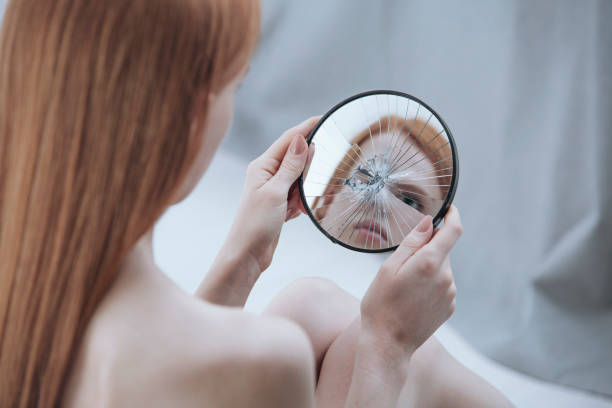Dysmorphophobia
 Photo courtesy of iStockOpens in new window
Photo courtesy of iStockOpens in new window
The initial formulation of the clinical category of dysmorphophobia (which literally means fear of being ugly) resulted from a term coined by Enrico MorselliOpens in new window during the late nineteenth century. |
Dysmorphophobia referred to specifiable behaviors that described having an “attitude” toward parts of oneself and/or one’s body and often referred to as an imagined ugliness.
Dysmorphophobia disorder has been depicted for more than a century and has been reported to exist around the world. This concept was commonly referenced in European literature during the 1960s and 1970s but was not formally introduced in the United States until its appearance in DSM-III-R (American Psychatric Association, 1987).
As an interesting aside, the DSM-IV editors felt the term dysmorphophobia is somewhat misleading and inaccurately suggests the presence of phobic avoidance.
Consequently, they decided to relabel dysmorphophobia as body dysmorphic disorder (BDD) in order to avoid any clinical confusion.
A central feature to remember about body dysmorphic disorder is the persons’s preoccupation about some imagined defect in their body.
Virtually any body part can be the focus of concern. The individual is greatly preoccupied with the notion that something is very wrong with the shape, size, or appearance of some part of his or her body.
Many people with BDD become fixated on mirrors, frequently checking for some presumed ugly feature to see if any change has taken place, or they might avoid reflective surfaces altogether (Veale & Riley, 2001). If there happens to be some slight physical defect present, the concern is grossly exaggerated and well in excess of what is considered normal.
Although the individual with BDD is continually distressed about his or her appearance, he or she appears perfectly normal to others. This preoccupation with physical appearance includes extreme self-consciousness and embarrassment, excessive importance given to appearance in self-evaluation, avoidance of activities, body camouflaging, and a pattern of constant body checking.
Keep in mind that body dysmorphic disorder does not refer to persons who are grossly disfigured or have a deformed appearance and realistically need multiple plastic surgeries (Anderson, 2003).
Prevailing Pattern
Body dysmorphic disorder includes the following features:
- The individual is preoccupied with an imagined defect in their appearance or is excessively concerned about a slight phsycial anomaly.
- The individual’s preoccupation causes significant distress or impairs several important areas of interpersonal functioning (e.g., family, social relationships, or at work).
- The individual’s preoccupation is not better explained by another disorder (e.g., anorexia nervosa) (American Psychiatric Association, 2000).
The most common symptoms of body dysmorphic disorder social workers will encounter in practice involve facial flaws such as wrinkles, spots and/or the texture of the skin, excessive facial hair, and the shape of certain features (e.g., the nose, jaw, mouth, eyes, or eyebrows).
It is common for individuals to be concerned about four different body areas, but the focus on a particular “flawed” body part will sometimes change from one site to another. For example, someone who is worried about wrinkles on their face may have plastic surgery and afterwards “discover” that his or her lips are not full enough and therefore appear grotesque.
They may also go to great lengths to camouflage a “flawed” appearance by using excessive amounts of makeup, clothing, or hats. Still others can be found tanning themselves excessively to hide skin defects (Phillips, Menard, Fay, & Weisburg, 2005).
In sum, their lives are significantly affected, as they tend to withdraw from most social and occupational activities. In severe cases, the person may become housebound to hide the perceived deformity.
To give an idea of the desperation those who struggle with BDD have about their perceived distorted appearance, Veale (2000) describes several cases in which individuals had performed “DIY” surgery wherein they attempted by their own hand to alter their appearance dramatically after they were either turned down for or could not afford surgery.
For instance, one man was so concerned about the loose skin around his face that he took a staple gun to both sides of his face to tighten his skin. Needless to say, the results were disastrous. The staples fell out after a couple of minutes and he almost damaged a facial nerve. Another woman who was unable to afford liposuction for what she saw as ugly parts of her body cut open her thighs and attempted to squeeze out the fat.
- Wilhelm, Sabine. Cognitive-behavioral therapy for body dysmorphic disorder: a treatment manual/Sabine Wilhelm, Katharine A. Phillips, and Gail Steketee.
- Pope, C., Pope, H., Menard, W., Fay, C., Olivardia, R., & Philips, K. (2005). Clinical features of muscle dysmorphia among males with body dysmorphic disorder. Body Image, 4, 385 – 400.
- Veale, D., & Riley, S. (2001). Mirror, mirror on the wall, who is the ugliest of them all? The psychopathology of mirror grazing in body dysmorphic disorder. Behavior Research and Therapy 39, 1381 – 1393.
- Woolfolk, R. L., & Allen, L. A. (2011). Somatoform and physical disorders. In D. H. Barlow, (ed.), The Oxford handbook of clinical psychology, (pp. 334 – 358). New York, NY: Oxford University Press.

